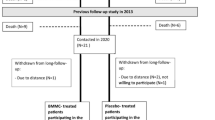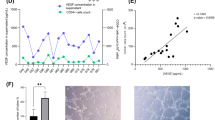Abstract
Recent experimental studies have shown that granulocyte-colony-stimulating factor (G-CSF) enhanced cardiac function after infarction. The concept of direct cytokine or cell-mediated effects on postischemic myocardial function was tested in the setting of human myocardial infarction subjected to percutaneous coronary intervention. In the FIRSTLINE-AMI study 50 consecutive patients with first ST-elevation myocardial infarction were randomly assigned to receive either 10 μg/kg G-CSF for 6 days after percutaneous coronary intervention in addition to standard medication, or standard care alone. G-CSF administration led to mobilization of CD34+ mononuclear stem cells (MNCCD34+), with a 20-fold increase to 64 ± 37 MNCCD34+/μl at day 6 without significant associated changes in rheology, blood viscosity or inflammatory reaction, or any major adverse effects. At 4 months the G-CSF group showed improved left ventricular ejection fraction of 54 ± 8% versus 48 ± 4% at baseline (P <0.001), and no evidence of left ventricular end-diastolic remodeling, with a diameter of 55 ± 5 mm and improved segmental wall thickening (P <0.001); conversely, in control patients left ventricular ejection fraction was 43 ± 5% at 4 months (P <0.001), with increased left ventricular end-diastolic dimension of 58 ± 4 mm (P <0.001), and no segmental wall thickening. In conclusion, the FIRSTLINE-AMI study showed that G-CSF administration and mobilization of MNCCD34+ after reperfusion of infarcted myocardium may offer a pragmatic strategy for preservation of human myocardium and prevention of remodeling without evidence of aggravated atherosclerosis.
This is a preview of subscription content, access via your institution
Access options
Subscribe to this journal
Receive 12 print issues and online access
$209.00 per year
only $17.42 per issue
Buy this article
- Purchase on Springer Link
- Instant access to full article PDF
Prices may be subject to local taxes which are calculated during checkout


Similar content being viewed by others
References
Orlic D et al. (2001) Bone marrow cells regenerate infarcted myocardium. Nature 410: 701–705
Anversa P and Nadal-Ginard B (2002) Myocyte renewal and ventricular remodeling. Nature 415: 240–243
Strauer BE et al. (2002) Repair of infarcted myocardium by autologous intracoronary mononuclear bone marrow cell transplantation in humans. Circulation 106: 1913–1918
Assmus B et al. (2002) Transplantation of progenitor cells and regeneration enhancement in acute myocardial infarction (TOPCARE-AMI). Circulation 106: 3009–3017
Makino S et al. (1999) Cardiomyocytes can be generated from marrow stromal cells in vitro. J Clin Invest 103: 697–705
Orlic D et al. (2001) Mobilized bone marrow cells repair the infarcted heart, improving function and survival. Proc Natl Acad Sci USA 98: 10344–10349
Quaini F et al. (2002) Chimerism of the transplanted heart. N Engl J Med 346: 5–15
Glaser R et al. (2002) Smooth muscle cells, but not myocytes, of host origin in transplanted human hearts. Circulation 106: 17–19
Muller P et al. (2002) Cardiomyocytes of noncardiac origin in myocardial biopsies of human transplanted hearts. Circulation 106: 31–35
Laflamme MA et al. (2002) Evidence for cardiomyocyte repopulation by extracardiac progenitors in transplanted hearts. Circ Res 90: 634–640
Frangogiannis NG et al. (2002) The inflammatory response in myocardial infarction. Cardiovasc Res 53: 31–47
Frangogiannis NG et al. (2003) MCSF expression is induced in healing myocardial infarcts and may regulate monocyte and endothelial cell phenotype. Am J Physiol 285: 483–492
Massa M et al. (2005) Increased circulating hematopoietic and endothelial progenitor cells in the early phase of acute myocardial infarction. Blood 105: 199–206
Kajstura J et al. (2005) Bone marrow cells differentiate in cardiac cell lineages after infarction independently of cell fusion. Circ Res 96: 127–137
Murry CE et al. (2004) Haematopoietic stem cells do not transdifferentiate into cardiac myocytes in myocardial infarcts. Nature 428: 664–668
Balsam LB et al. (2004) Haematopoietic stem cells adopt mature haematopoietic fates in ischaemic myocardium. Nature 428: 668–673
Kocher AA et al. (2001) Neovascularization of ischemic myocardium by human bone-marrow-derived angioblasts prevents cardiomyocyte apoptosis, reduces remodeling and improves cardiac function. Nat Med 7: 430–436
Wojakowski W et al. (2004) Mobilization of CD34/CXCR4+, CD34/CD117+, c-met+ stem cells, and mononuclear cells expressing early cardiac, muscle, and endothelial markers into peripheral blood in patients with acute myocardial infarction. Circulation 110: 3213–3220
Vulliet PR et al. (2004) Intra-coronary arterial injection of mesenchymal stromal cells and microinfarction in dogs. Lancet 363: 783–784
Balagner H et al. (2004) Splenic rupture after granulocyte-colony-stimulating factor mobilization in a peripheral blood progenitor cell donor. Transfusion 44: 1260–1261
O'Malley DP et al. (2003) Spontaneous splenic rupture with fatal outcome following G-CSF administration for myelodysplastic syndrome. Am J Hematol 73: 294–295
Minatoguchi S et al. (2004) Acceleration of the healing process and myocardial regeneration may be important as a mechanism of improvement of cardiac function and remodelling by postinfarction granulocyte colony-stimulating factor treatment. Circulation 109: 2572–2580
Harada M et al. (2005) G-CSF prevents cardiac remodeling after myocardial infarction by activating the Jak-Stat pathway in cardiomyocytes. Nat Med 11: 305–311
Author information
Authors and Affiliations
Corresponding author
Ethics declarations
Competing interests
The authors declare no competing financial interests.
Rights and permissions
About this article
Cite this article
Nienaber, C., Petzsch, M., Kleine, H. et al. Effects of granulocyte-colony-stimulating factor on mobilization of bone-marrow-derived stem cells after myocardial infarction in humans. Nat Rev Cardiol 3 (Suppl 1), S73–S77 (2006). https://doi.org/10.1038/ncpcardio0443
Received:
Accepted:
Issue Date:
DOI: https://doi.org/10.1038/ncpcardio0443
This article is cited by
-
Endothelial progenitor cells and their potential clinical implication in cardiovascular disorders
Journal of Endocrinological Investigation (2009)
-
The potential of hematopoietic growth factors for treatment of Alzheimer's disease: a mini-review
BMC Neuroscience (2008)
-
A Meta-Analysis of Stem Cell Mobilization by Granulocyte Colony-Stimulating Factor in the Treatment of Acute Myocardial Infarction
Cardiovascular Drugs and Therapy (2008)



